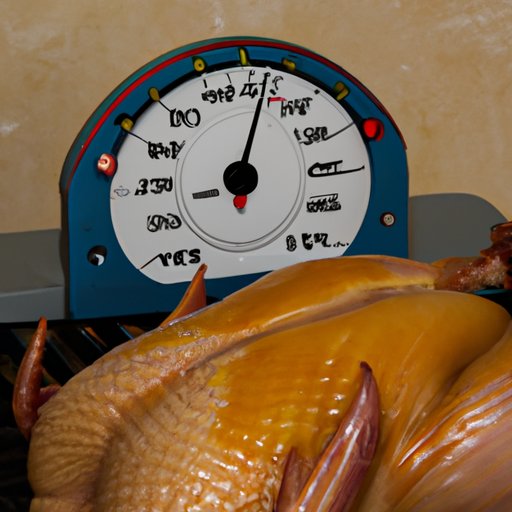Introduction
Cooking a turkey can be a daunting task – especially if you’ve never done it before! Knowing when a turkey is done cooking is a key element in ensuring that your bird is safe to eat and delicious. This article will provide an in-depth guide to help you determine when your turkey is fully cooked and ready to serve.
How to Tell When a Turkey is Fully Cooked
When a turkey is roasted to perfection, it should be juicy, tender, and flavorful. To achieve this ideal result, there are a few steps you can take to make sure your bird is done cooking. Here is a definitive checklist for perfectly cooked turkey:
An In-Depth Guide to Gauging the Doneness of a Roasted Turkey
- Check the internal temperature of the thickest part of the thigh with a meat thermometer.
- Check for clear juices running from the bird when pierced with a fork.
- Look for a golden brown color on the skin.
- The leg should move easily when pulled away from the body.
What Temperature Should a Roasted Turkey Reach Before it is Done?
The most important factor in determining when a turkey is done cooking is its internal temperature. The U.S. Department of Agriculture recommends that all poultry reach an internal temperature of at least 165 degrees Fahrenheit before it is consumed. This temperature should be measured in the thickest part of the thigh without touching the bone. If the turkey has been stuffed, the stuffing also needs to reach a minimum temperature of 165 degrees Fahrenheit.
Checking for Juices
When you pierce the thickest part of the thigh with a fork or knife, the juices should run clear. If they are still pink, the turkey needs more time in the oven. However, keep in mind that even when the juices run clear, the turkey may not yet be fully cooked. It’s important to check the internal temperature as well.
Color and Texture
A perfectly cooked turkey should have golden brown skin. You can check this by looking through the oven window or by using a kitchen light. The leg should also move easily when pulled away from the body. If it doesn’t, the turkey needs more time in the oven.

Tips and Tricks for Knowing When Your Turkey is Ready to Serve
Cooking a turkey can be a complicated task, but there are some tips and tricks that can help you ensure that your bird is done cooking. Here are a few helpful hints to keep in mind:
Use a Meat Thermometer
Using a meat thermometer is the best way to ensure that your turkey is cooked to the correct internal temperature. Insert the thermometer into the thickest part of the thigh, making sure that it does not touch the bone. This will give you an accurate reading of the internal temperature so you can be sure that your turkey is done cooking.
Avoid Overcooking
It’s important to avoid overcooking the turkey, as this can lead to dry, flavorless meat. Check the internal temperature and other indicators (juices, color, texture) regularly to make sure you don’t overcook the bird. Once the turkey has reached the recommended internal temperature, remove it from the oven and let it rest before carving.
Let the Turkey Rest
Once the turkey has reached the desired internal temperature, it’s important to let it rest before carving. This will allow the juices to redistribute throughout the bird, resulting in a juicier and more flavorful meal. Let the turkey rest for at least 15 minutes before carving.
Conclusion
Knowing when a turkey is done cooking is essential to ensuring a safe and delicious meal. By following the definitive checklist for perfectly cooked turkey – checking the internal temperature, checking for juices, looking for a golden brown color, and making sure the leg moves easily – you can be sure that your bird is done cooking and ready to serve. Remember to use a meat thermometer, avoid overcooking, and let the turkey rest before carving for best results.


